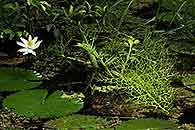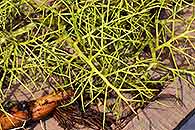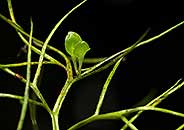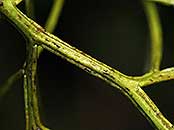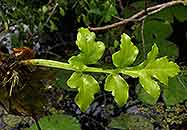Synonyms |
Ceratopteris cornuta (P. Beauv.) Lepr.
Pteris cornuta P.Beauv.
Acrostichum thalictroides L.
Pteris thalictroides (L.)Sw.
|
Common name |
|
Description |
Rhizome erect, short. Fronds tufted, dimorphous. Stipe up to 25 cm long in sterile fronds, up to 40 cm long in fertile fronds, succulent and brittle when fresh, glabrous. Frond erect to arching, succulent, brittle, dimorphous.
Sterile lamina: up to 20-40 × 7-30 cm, obovate or narrowly triangular in outline, 2-3 pinnatifid, often proliferous; ultimate lobes triangular or lanceolate in outline, apex sharply to bluntly pointed, glabrous on both surfaces.
Fertile lamina longer and more dissected than sterile frond: 24-50 x 12-30 cm, narrowly to broadly ovate in outline, 2-4 pinnate; ultimate lobes narrowly linear, pointed, up to 40 × 1-2 mm, glabrous on both surfaces. Sporangia scattered along the veins; indusium marginal, entire, membranous. |
Notes | - In the photographed specimen both sterile and fertile fronds were proliferous
- Some authors distinguish 2 species: C. thalictroides and C. cornuta (Crouch et al. 2011, Burrows 1990, Jacobsen 1983). C. cornuta having less divided sterile fronds, shorter fertile fronds and broader ultimate segments. I have not been able to compare the 2 taxa and have for now opted to follow the broader approach, including C. cornuta under C. thalictroides. |
|---|
Derivation | |
|---|
Habitat | Free-floating or rooted aquatic plant of hot regions, in backwaters of pools, lakes and slow-flowing streams, seasonal water courses in scattered tree grassland, mud flats, exposed. |
|---|
Distribution worldwide | Africa, Cape Verde Isl., Madagascar, Seychelles, Socotra, widespread in Australia and Asia. |
|---|
Distribution in Africa |
Angola, Benin, Burkina Fasso, Burundi, Cameroon, Chad, Congo, Dem. Republic of Congo, Ethiopia, Gabon, Ghana, Guinea Bissau, Ivory Coast, Kenya, Liberia, Mali, Mozambique, Nigeria, Senegal, Sierra Leone, Somalia, South Africa, Sudan and South Sudan, Swaziland, Tanzania , Togo, Uganda, Zambia, Zimbabwe. |
Growth form |
Aquatic. |
Literature |
Burrows, J.E. (1990) Southern African Ferns and Fern Allies. Frandsen, Sandton. Pages 112 - 114. (Includes a picture).
Crouch, N.R., Klopper, R.R., Burrows, J.E. & Burrows, S.M. (2011) Ferns of Southern Africa, A comprehensive guide. Struik Nature. Pages 300 - 301. (Includes a picture).
Jacobsen, W.B.G. (1983) The Ferns and Fern Allies of Southern Africa. Butterworths, Durban and Pretoria. Page 218. (Includes a picture).
Kornas, J. (1979) Distribution and ecology of the Pteridophytes in Zambia. Polska Akademia Nauk Wydzial II Nauk Biologicznych. Pages 44 - 45.
Lawalrée, A. (1969) Parkeriaceae.Flore du Congo, du Rwanda et du Burundi, Pages 2 - 3. (Includes a picture).
Roux, J.P. (2001) Conspectus of Southern African Pteridophyta.Southern African Botanical Diversity Network Report, 13 Page 55.
Roux, J.P. (2009) Synopsis of the Lycopodiophyta and Pteridophyta of Africa, Madagascar and neighbouring islands. Strelitzia 23, South African National Biodiversity Institute, Pretoria. Page 150.
Schelpe, E.A.C.L.E. (1970) Pteridophyta.Flora Zambesiaca, 0 Pages 102 - 105. (Includes a picture).
Tardieu-Blot, M.-L. (1964) Ptéridophytes vol.3.Flore du Cameroun, Pages 129 - 130. (Includes a picture).
Thardieu-Blot, M.L. (1964) Ptéridophytes vol.8.Flore du Gabon, Page 99. (Includes a picture).
Verdcourt, B. (1999) Parkeriaceae.Flora of Tropical East Africa, Pages 1 - 4. (Includes a picture).
|
